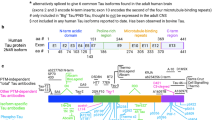Abstract.
Huntington's Disease (HD) is an inherited progressive neurodegenerative disorder associated with a mutation in a gene expressed in both affected and non-affected tissues. The selective neuropathology in HD is thought to be mediated in part through interactions with other proteins including the Huntington Associated Protein, HAP-1, which is predominantly expressed in the brain. We have mapped its murine homolog, Hap1, to mouse Chr 11 (band D), which shares extensive synteny with human Chr 17 including the region 17q21–q22, where the gene for `frontotemporal dementia and parkinsonism linked to chromosome 17' has bee mapped. In addition, we have sequenced a 21,984 base pair (bp) genomic clone encompassing the entire Hap1 gene. It is organized as 11 exons and flanked by exons from potentially one or more novel genes. At least three Hap1 transcripts (Hap1-A; Hap1-B; Hap1-C) can be formed by alternative splicing at the 3′ end of the gene leading to protein isoforms with novel C-termini.
Similar content being viewed by others
Author information
Authors and Affiliations
Rights and permissions
About this article
Cite this article
Nasir, J., Duan, K., Nichol, K. et al. Gene structure and map location of the murine homolog of the Huntington-associated protein, Hap1 . 9, 565–570 (1998). https://doi.org/10.1007/s003359900819
Issue Date:
DOI: https://doi.org/10.1007/s003359900819




